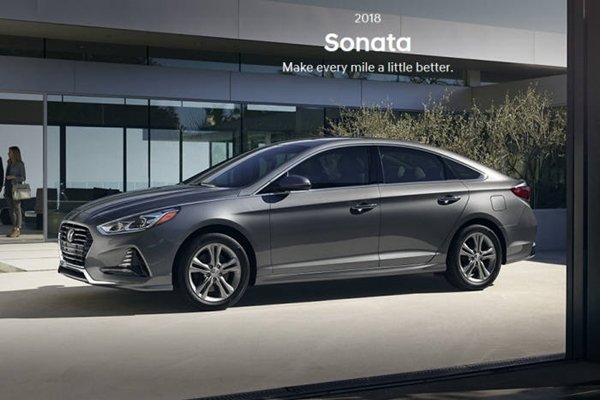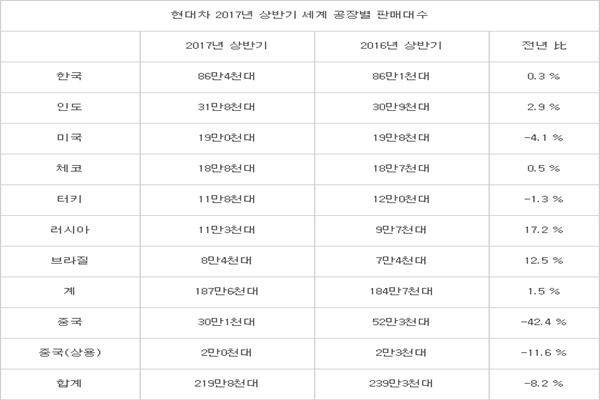Hyundai Motor Company is facing sales slump for two quarters in a row mainly by sharp decline of sales volume in China. As number of sales fell from more than 500,000 to 360,000, its operating profit for second quarter ($1.20 billion (1.3445 trillion KRW)) decreased by 23.7% compared to second quarter of last year.
Hyundai Motor Company is looking to rebound itself through expansion of lineup of SUVs and eco-friendly cars. It is also planning to release 6 new energy vehicles such as electric vehicles one by one in Chinese market in order to recover its sales volume that it lost in Chinese market.
Hyundai Motor Company held a conference call for its management performance for first half of 2017 at its headquarters in Seoul on the 26th and announced its performance up until first half of 2017. It made $21.5 billion (24.038 trillion KRW) and $816 million (913.6 billion KRW) in sales and net profit respectively during second quarter. Compared to second quarter of last year, its sales and net profit for this year’s second quarter decreased by 1.5% and 48.2% respectively. During first half of this year, it made $42.6 billion (47.674 trillion KRW), $2.32 billion (2.5952 trillion KRW), and $2.07 billion (2.3193 trillion KRW) in sales, operating profit, and net profit respectively. Although its sales increased by 1.4% compared to first half of last year, its operating profit and net profit decreased by 16.4% and 34.3% respectively.
Its sales volume for first half of 2017 was 2,197,689 which is 8.2% decrease compared to first half of last year. Fact that its sales volume in China decreased from 507,000 in first half of last year to 361,000 in first half of this year has had greatest impact on its performance. Its sales volume in South Korea was 344,130 which is 1.7% decrease compared to first half of last year. Although it showed satisfactory grow in sales in foreign markets such as Russia and Brazil with its vehicle called ‘Creta’ at the center, its overall sales volume of entire foreign markets w#as 1,853,559, which is 9.3% decrease compared to first half of last year, due to decrease in sales volume in Chinese market.
Sales of first half of this year increased by 1.4% due to increase in sales from automotive and financial departments. Its rate of cost of sales was 81.1%, which is 0.8% increase from first half of last year, as won showed strength compared to major currency such as dollar and as incentives in major markets as the U.S. increased. It made 2.61 billion (2.922 trillion KRW) in ordinary profit of first half of this year, which is 35.7% decrease compared to first half of last year, due to reduction of profit that was caused by weak performance by Beijing Hyundai Motor Company.

“Our sales volume in foreign markets excluding Chinese market has increased despite of difficult situations such as reduction of sales volume in Chinese market due to continuous positive sales of Grandeur in South Korean market and release of ‘Creta’ in rising markets.” said a representative for Hyundai Motor Company. “However profitability of first half of this year is decreased from profitability of first half of last year due to increase in incentives and strong won with areas such as the U.S. where demands are slow at the center.”
Hyundai Motor Company is planning to break breakthroughs in markets by diversifying its SUV lineups and strengthening its eco-friendly car lineups such as fuel cell electric vehicles. It is also going to expand its eco-friendly car lineup, which is actively supported by Chinese Government, in order to go after Chinese markets again.
“Sales volume of our eco-friendly cars such as IONIQ Electric for first half of 2017 was 45,000 which is 74% increase compared to first half of last year.” said a representative for Hyundai Motor Company. “We are going to greatly expand our SUV lineups by releasing fuel cell electric vehicles and KONA during first half of next year.” Hyundai Motor Company is planning to expand its SUV lineup from A segment to E segment by 2020 and increase sales and market shares of SUVs by lowering percentage of sedans through variety of strategies for SUVs.
“We are going to release 6 new energy vehicles such as electric vehicle called ‘Celesta’ in Chinese market by 2020 so that we can actively respond to rapidly changing market environment such as Chinese market that established a system that obligates automotive manufacturers to produce new energy vehicles.” said a same representative for Hyundai Motor Company.
Staff Reporter Ryu, Jongeun | rje312@etnews.com & Staff Reporter Park, Taejoon | gaius@etnews.com
